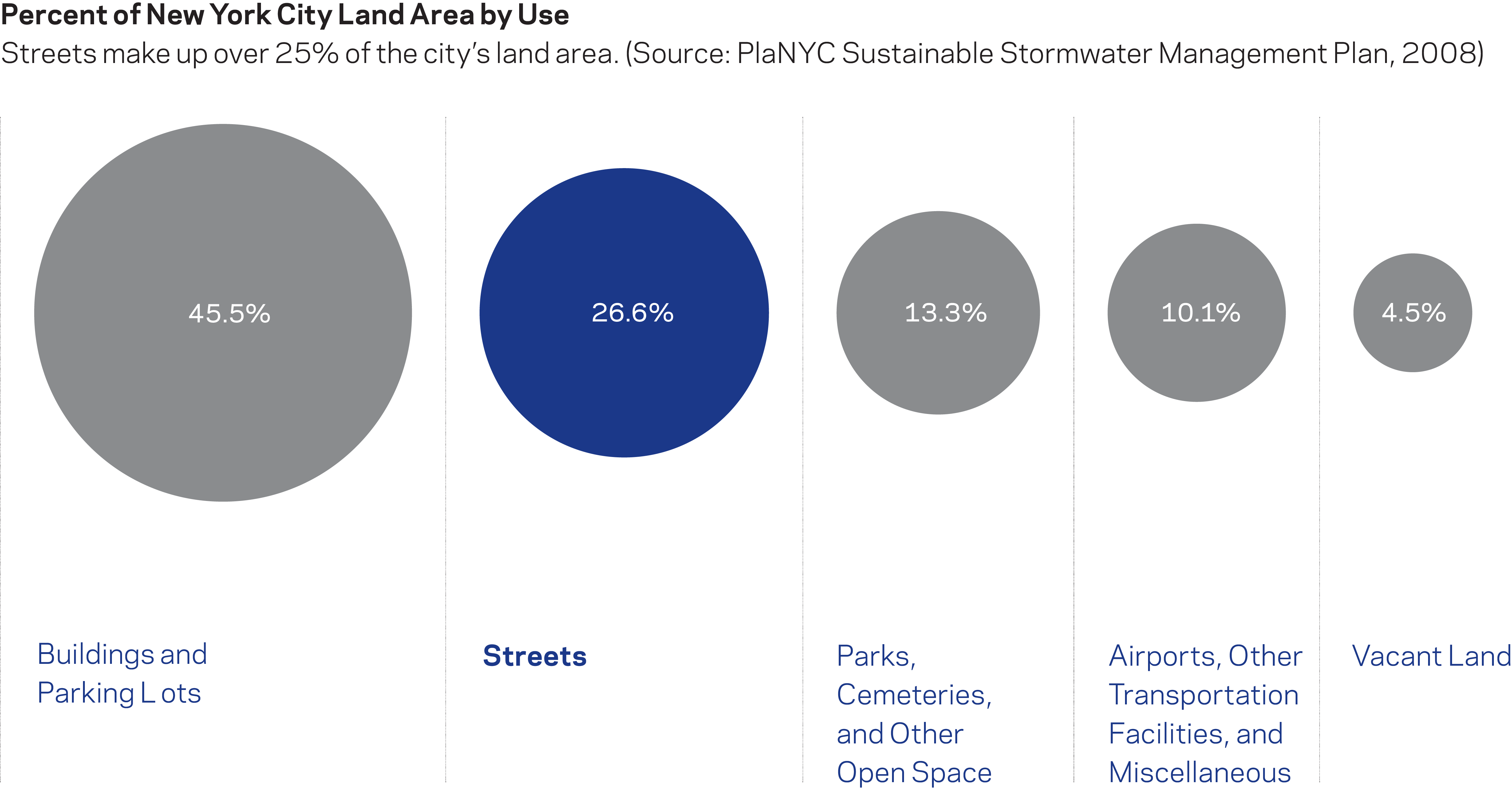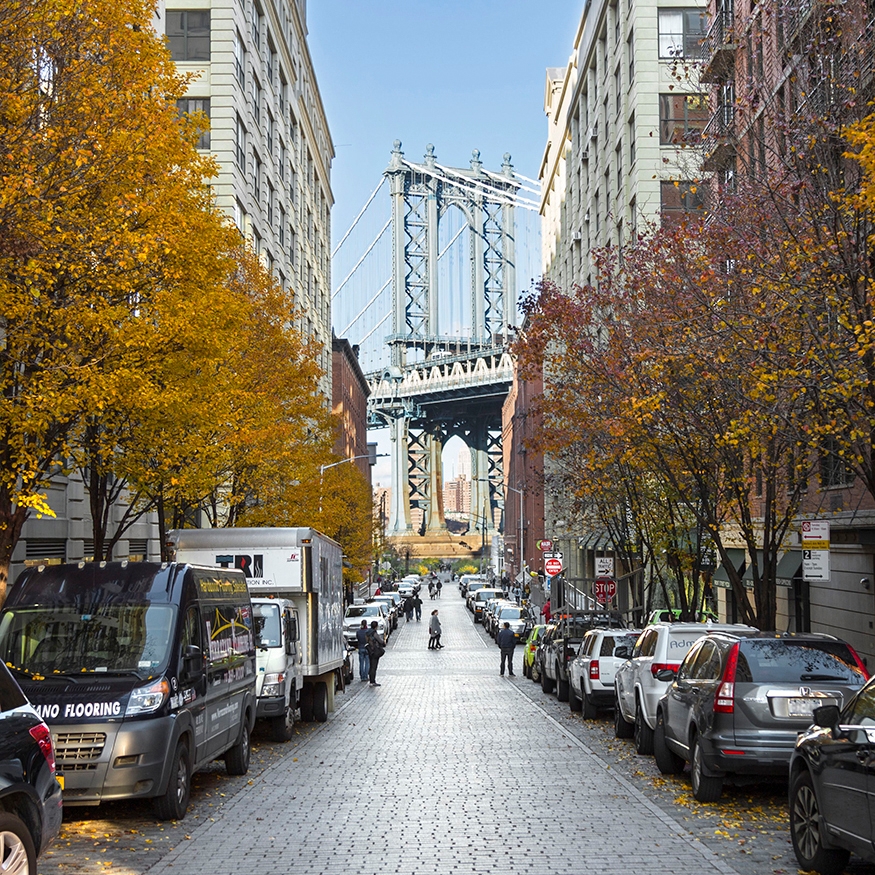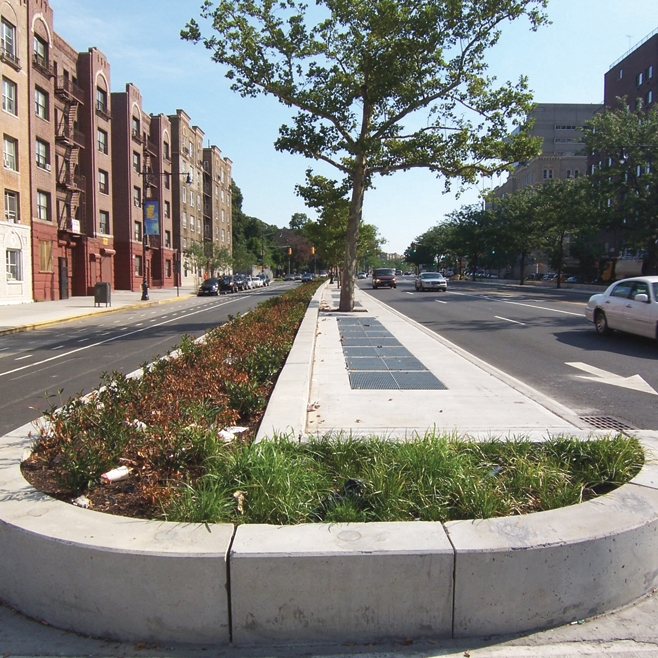Planning and designing streets in accordance with the goals and principles of this section will contribute to a consistent level of quality and functionality for New York City’s streets. Along with a project’s planning framework, the goals and principles should be used to resolve conflicting priorities for limited street space.

Goals & Principles
Demand for street space in New York City will always outstrip supply, and it is DOT’s responsibility to design streets and allocate space to encourage the transportation modes that move people and goods most efficiently. Accordingly, consistent with the city’s OneNYC 2050 plan, the city prioritizes walking, cycling, and transit when redesigning streets and allocating use of the streetscape. In applying this framework, projects must also consider freight operations.

Practitioners should adhere to the following goals and principles when designing city streets, with an eye to achieving the highest possible aesthetic standards. DOT seeks to design streets that are:
- Safe
- Balanced and Inclusive
- Vibrant
- Contextual
- Sustainable and Resilient
- Cost-effective and Maintainable
Operational safety enhancements: Flatbush Avenue, Brooklyn
Safe
In 2014, the city introduced its Vision Zero campaign to enhance street safety through engineering, education, and enforcement. These efforts have contributed to a decrease in the number of traffic fatalities and serious injuries. Designing safe streets will continue to be the first priority for DOT.
- Prioritize walking, cycling, use of mobility devices for those with disabilities, and other nonautomotive modes.
- Design streets for slower speeds to discourage speeding and increase driver attention.
- Use crash data to assist with decision-making.
- Research, test, and evaluate innovative safety treatments, particularly those successfully adopted in other cities.
- Provide consistent lighting for all users to ensure safe operation of streets and sidewalks.
Roadway design for multiple modes: 1st Avenue, Manhattan
Balanced and Inclusive
Street designs should enable the movement of street users of all ages and abilities, prioritizing space-efficient modes capable of providing mobility to the largest number of people. Streets should balance the needs of people and vehicles within neighborhoods and movement through them.
- Provide convenient and comfortable facilities for walking, cycling, and transit, particularly on designated routes and at critical network connections.
- Meet or exceed 2010 ADA Standards for Accessible Design.
- Accommodate delivery of goods for businesses and residents.
- Ensure emergency vehicle access.
Dance performance at Summer Streets: Park Avenue, Manhattan
Vibrant
Beyond their use for moving people and goods, streets comprise an extensive network of public open spaces that facilitate social, civic, and economic interactions.
- Expand usable public open space by reallocating underutilized roadway space.
- Encourage physical health and activity for all ages and populations by making walking, cycling, and transit safe, attractive, and convenient.
- Design streets to be flexible and allow for multiple activities and public programming.
- Install public seating and bike parking.
- Encourage temporary and permanent public art installations.
- Maximize street trees and other plantings.
Cobblestone roadway: Washington Street, Brooklyn
Contextual
Streets help define the character of neighborhoods. Both standard and distinctive design treatments— including furniture, materials, lighting, and landscape—should relate to the surrounding context, including its history, land uses, and nearby landmarks.
- Preserve the unique character of neighborhoods.
- Maintain design consistency within neighborhoods and corridors.
- Reduce clutter of structures and signs that are outdated or no longer necessary.
- Support connections to adjacent land uses by providing gathering spaces and pedestrian access to and from major destinations.
Bioswale to filter stormwater: Dean Street, Brooklyn
Sustainable and Resilient
Streets present an extraordinary opportunity to improve the environmental health of the city. When designed to be resilient, streets can help communities withstand and bounce back from climate-related events.
- Collaborate across agencies in testing, evaluating, and standardizing new materials so that streets are constructed in an increasingly environmentally-sound way, and respond effectively to climate threats.
- Plan for resiliency by analyzing the risks associated with sea-level rise, coastal storms, and extreme precipitation and heat.
- Minimize impermeable surfaces and maximize plantings and stormwater capturing installations.
- Utilize resilient materials that can withstand periodic temporary inundation.
- Reduce streets’ rate of heat absorption by maximizing tree canopy cover.
- Minimize the overall lifecycle energy use and pollution associated with projects, including the extraction, transportation, construction, maintenance, and replacement of materials.
Raised median: Grand Concourse, Bronx
Cost-effective and Maintainable
Reconstruction of city streets requires substantial financial resources. The list of worthy projects competing for a limited pool of funding is extensive. Street designs need to be cost-effective and maintainable for the long-term.
- Consider lifecycle costs and maintenance needs in addition to up-front capital costs.
- Ensure interagency coordination on projects that impact streets to reduce redundancy.
- Design streets to meet the city’s future needs. Because streets are reconstructed infrequently, consider future conditions and demands during the planning process.
- Maintain a clear and consistent design-review process to reduce change orders and the time it takes to complete projects.
- Establish well-considered and clearly defined goals early in project development, and focus on meeting those goals throughout planning and design.
- Pilot and evaluate new materials and treatments likely to reduce construction and operating costs.
Design Considerations
To define context, set project goals, and help give appropriate thought to the full range of factors that should inform a street’s design, refer to this list of design considerations. While this is not an exhaustive list, projects submitted to DOT for approval will be reviewed with respect to these topic areas.
Use
Streets must accommodate many different users and serve a variety of functions.
- Buses and paratransit
- Cycling
- Emergency vehicles and access
- Flood protection/coastal surge barrier
- Motor vehicles
- Programming and special events
- Public space
- Sanitation
- School buses
- Stormwater management practices
- Trucks and goods movement
- Walking
Performance
The operational conditions of a street both respond to and inform street design.
- Access and circulation (e.g., one-way or two-way)
- Exposure of road users to vehicular traffic
- Crash history
- Curb cuts
- Curbside demand, e.g., parking, loading zones
- Multimodal Conflict Points
- Pedestrian, cyclist, and vehicular volumes
- Pedestrian and vehicular level of service (LOS)
- Roadway and sidewalk condition
- Role of a street in transportation network
- Traffic controls
Streetscape Elements
Furnishings on the sidewalk or in curbside lanes serve a variety of functions and enhance streetscape vibrancy.
- Bike parking
- Plantings and green infrastructure
- Public art
- Seating
- WalkNYC Wayfinding
Community Context
Each street is unique and streets should be planned and designed with an understanding of their role in both the local and larger planning contexts.
- Combined Sewer Overflow (CSO) Priority Areas
- Commercial corridors
- Community Boards and elected representatives
- Contamination and remediation
- DCP studies, anticipated density change
- FEMA Flood Zones and floodplains
- Historic districts and special zoning
- Land uses, e.g., commercial, industrial, residential
- Maintenance partners and capacity
- Neighborhood character
- Proximity to transit
- School- or senior-safety zones
- Trip generators, e.g., landmarks; institutions
- Wetlands, coastlines, and conservation areas
Physical Constraints
Some physical elements and characteristics are costly, challenging, or impossible to change or relocate, creating constraints for the design process, while others are less costly and challenging.
- Building ingress/egress
- Column supports for elevated structures
- Comfort levels, e.g., wind, protection from sun
- Daylighting and sightlines
- Grading and drainage
- Healthy trees
- Lights
- Poles
- Retaining walls
- Roadway width and variations in roadway width
- Sewer catch basins
- Soil structure and permeability
- Street grid
- Turning radii
- Utilities, e.g., underground gas, sewer, water
The Planning Framework
This section provides an overview of the larger planning framework for streets, which includes the street design considerations outlined in the previous section. It establishes the context and priorities for each street project and considers the ongoing management and operation of the completed project. DOT evaluates the costs and effectiveness of treatments and management strategies to inform future designs and initiatives. Consult the Resources page for useful resources for best planning practices for streets.
Planning
Every street is inseparable not only from its surrounding community and land uses but also from the larger transportation network of the city and region. Streets should be designed with an understanding of their role in both local and larger planning contexts. The planning of street projects should begin with the setting of clearly defined goals. Projects should seek to address not only pre-existing issues that have been identified by the community or the city, but also policy objectives or other needs of the city and stakeholders. Appropriate stakeholders should be involved in projects from conception to implementation.
Design
The Street Design Manual’s design guidance includes options for geometric, material, lighting, furnishing, and landscape treatments; in most cases it does not prescribe which specific treatments must be used and in which combination. It also does not dictate which treatment should receive priority when there is a conflict between design alternatives. Rather, it gives users the flexibility to determine which overall design is most appropriate and practical in light of the goals and priorities established through the planning process and the policies enumerated in this Manual. The Design Considerations list in the previous section can be a particularly helpful tool for this decision-making process.
Management
Well-functioning, high-quality streets are not just a product of their planning and design; the way a street is operated and managed once built is just as important as its design. For example, curbside regulations and traffic controls (signs, signals, and markings) are a central factor in determining how streets operate and the quality of the public realm. Likewise, access to a street, sidewalk, or plaza can be limited to pedestrian traffic or specific public programming on certain days or for certain hours, and vehicular traffic can be limited to transit and/or commercial vehicles some or all of the time. Finally, maintenance of street materials, furnishings, and plantings is critical to the long-term success of street designs.

Community planning workshop for Citi Bike expansion in Community Board 1: Astoria, Queens







